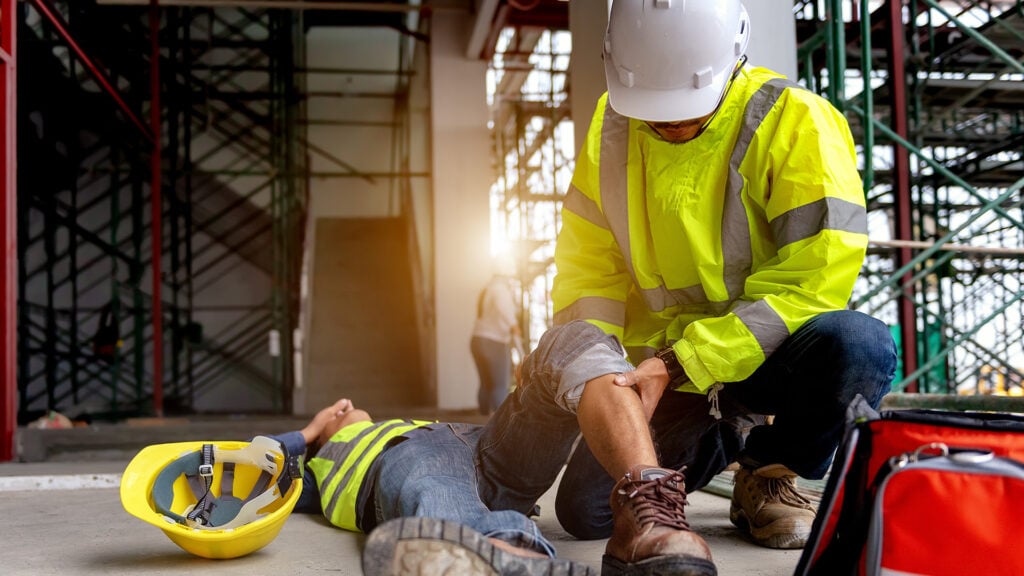A well-prepared response begins with understanding the key steps for performing first aid on-site. Every construction site must have trained first-aid providers. OSHA mandates this if no nearby medical facility is available. In emergencies, anyone on-site may need to step in. Preparation is key; knowing the proper steps can make all the difference. Your goal is to save lives and prevent further harm. Continuous training and practice ensure you’ll be ready when it counts.
Construction sites come with many risks, and understanding how to respond to common injuries is essential for workplace safety.
Cuts, Lacerations, and Impalements
Quick action is crucial to control bleeding and prevent infections during cuts, lacerations, or impalements.
- For Minor Cuts and Scrapes:
- Apply gentle pressure to stop bleeding.
- Rinse the wound with clean water—avoid using cleansers inside the wound.
- Apply antibacterial ointment and cover with a clean bandage.
- For Impalements:
- Do not remove the object, as this can cause excessive bleeding.
- Apply pressure around the object and elevate the affected area.
- For Severe Lacerations or Amputations:
- Use tourniquets or bandages to control bleeding.
- Keep amputated body parts cool, but avoid direct contact with ice.
- Monitor for signs of shock or cardiac arrest while waiting for emergency personnel.
Burn injuries can vary in severity, and knowing how to treat them effectively can minimize damage and discomfort.
- For Minor Burns:
- Run cool water over the area or apply a cold compress.
- Use antibiotic cream or burn gel, then cover loosely with clean gauze.
- Avoid applying ice directly to the skin or rubbing the affected area.
- For Serious Burns:
- Apply a cool, moist bandage.
- Call 911 immediately.
- Do not immerse the victim in cold water—it can induce shock.
Sprains, strains, and fractures are common on physically demanding construction sites. Quick intervention can prevent further damage.
- For Minor Sprains and Strains, Follow the RICE Method:
- Rest the affected area.
- Ice to reduce swelling.
- Compression with a bandage.
- Elevation above heart level.
- For Fractures and Breaks:
- Keep the victim still to prevent further injury.
- Never attempt to set the bone yourself.
- Watch for signs of shock, internal bleeding, or head and spinal injuries.
Injuries to sensitive areas like the eyes and mouth require careful handling to avoid further damage.
- For Eye Injuries:
- Flush the eye with clean water or saline solution.
- Never attempt to remove embedded objects—use an eye shield and seek medical attention.
- For Mouth Injuries:
- Check for breathing blockages caused by broken teeth or swelling.
- Apply pressure to control bleeding and keep the victim upright.
Bites and stings can lead to infections or allergic reactions, so timely care is essential.
- Wash the area thoroughly and apply antibiotic ointment.
- Be vigilant for signs of allergic reactions or venom exposure.
Breathing difficulties and severe allergic reactions require immediate action to prevent life-threatening complications.
- For Anaphylaxis:
- Check if the victim has an epinephrine pen and assist them in using it.
- Call 911 and loosen tight clothing around their neck or chest.
- For Choking:
- Perform the Heimlich Maneuver: Stand behind the victim, place a fist just above their navel, and thrust sharply inward and upward.
- For unconscious victims, alternate back blows with abdominal thrusts.
Certain situations require immediate and specialized responses to protect lives on-site.
Cardiac Events and CPR
Responding to cardiac events effectively can save lives, especially with CPR training.
- For heart attacks:
- Ask if the victim has heart medication or aspirin.
- Call 911 and prepare to administer CPR if needed.
- For electrocutions:
- Ensure the power source is off before approaching the victim.
- Be prepared for burns or cardiac arrest.
Managing temperature-related injuries or shock is essential to stabilize the victim’s condition.
- For Shock:
- Lay the victim flat with legs elevated.
- Keep them warm and provide fluids if safe.
- For Heat Stroke:
- Move the victim to a cool area and provide hydration.
- Apply cool, damp cloths or gently pour cool water over them.
- For Hypothermia:
- Remove wet clothing and use warm, dry neck, chest, and groin compresses.
- Avoid direct heat or rubbing the skin.
Providing care doesn’t end with treatment—monitoring the victim and minimizing your risks is vital.
If the victim is unconscious but breathing, place them in the recovery position:
- Roll them onto their side with their top leg bent at the knee.
- Keep their airway clear and monitor their breathing until help arrives.
Reducing Risks While Administering First Aid
- Wear gloves and other PPE to avoid exposure to bloodborne pathogens.
- Be aware of environmental hazards like electrical currents or chemical spills.
Expand Your Knowledge with First Aid
First aid is about preserving life, preventing further harm, and promoting recovery. While this training provides foundational knowledge, continuous practice, and situational awareness are key to effective emergency response. For more comprehensive first aid training tailored to construction sites, enroll in our course: First Aid: Construction Sites Training Course.
References
Occupational Safety and Health Administration (OSHA) – First Aid Requirements for Construction Sites
Centers for Disease Control and Prevention (CDC) – Emergency Preparedness and Response
National Institute for Occupational Safety and Health (NIOSH) – Construction Safety and Health



